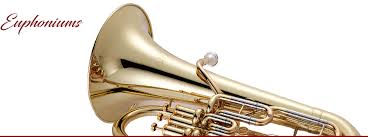
The euphonium is classified as a tenor voiced brass instrument in the woodwind family. The history of the euphonium can be traced back to the 19th century around 1843. It took combinations from the first patented piston valve by Heinrich Stolzel and Freidrich Blumel. The tenorbasshorn and the tenor tuba soon followed the invention of the piston and nearly 5 years later the euphonium was created. At first, it was called the “Euphonion” which comes from the Greek word “Euphonos” in English meaning sweet sounding.
The more modern euphonium was born around 1842. The inventors credited for this masterpiece include Adolf Sax, Meredith Wilson and a few other notable names in the music industry. Adolf Sax used his factory for wind instruments to create the euphonium. In the latter half of the 19th century, the Odiphiclide was replaced with the euphonium in all brass bands and military bands throughout the world. Both the ophediclide and the euphonium were not created for any specific religion, but as an improvement on the past instruments. The ease of pistons instead of covering holes and buzzing was much easier and the performer could play more notes with the valves.
The euphonium is made up of a combination of metal and brass. The valves and pistons have springs to press down and bounce back up once the pressure is lifted. The euphonium is played with a metal mouthpiece. To play, buzz the lips together and put them up against the mouthpiece. There are normally only 3-4 valves or pistons on the euphonium, so the notes are played by changing the embouchure and aperture of the lips in order to reach different overtone series. More modern day and expensive euphoniums will have a gold plating or silver plating on the brass finish. The metal must be hard enough that it will hold in place and not dent, but malleable enough and soft enough to get the warm low sound the euphonium creates.
The euphonium is mostly played in military, marching and brass bands. However, it also has its place in band and even orchestra sometimes. A famous orchestra work called Don Quixote follows a story of a man (represented by a euphonium soloist) journeying on his quest. In marching bands, euphoniums are often given the slow lyrical solos, but can also play loud and aggressively. There has not been any original compositions written for euphonium until the past few decades. Many literature is taken from tuba and horn books. Trombone and cello solos are a normalcy for euphonium players and occasionally they will transcribe oboe solos and flute solos for the euphoniums to expand the repertoire.
One of the most famous euphonium players in the United States is Demondrae Thurman. He is in a quartet called Sotto Voce with two tubist and another euphonium player. Low brass chamber music has become more popular as Demondrae became famous. He is a teacher at two universities for chamber ensemble, large ensemble and solo playing. He teaches how to play in a unique way while traveling the world touring with his group.
Written by Katilin Sepanek
Categories
Calendar
| M | T | W | T | F | S | S |
|---|---|---|---|---|---|---|
| 1 | 2 | 3 | 4 | 5 | 6 | |
| 7 | 8 | 9 | 10 | 11 | 12 | 13 |
| 14 | 15 | 16 | 17 | 18 | 19 | 20 |
| 21 | 22 | 23 | 24 | 25 | 26 | 27 |
| 28 | 29 | 30 | 31 | |||